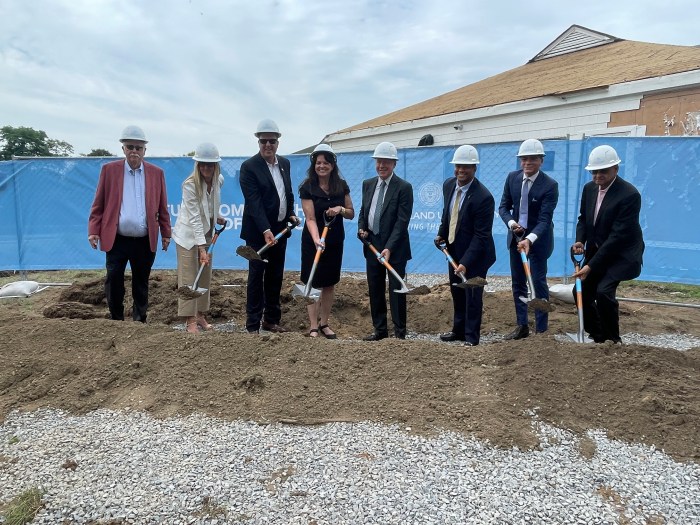Peg Wallace of Christina’s Epicure has been having wild turkey sightings, in back of the gourmet store on Route 106, off 25A in East Norwich. “Are they protesting the upcoming holiday perhaps, or maybe they saw the sign that said fresh turkey. One has even roosted in one of our shopping carts,” she said. Ms. Wallace sent photos of the lady turkeys walking up to the entrance of the store. “I’ve even seen some male turkeys,” she said.
Dianne Russo too has had some wild turkey sightings. Ms. Russo said, “I contacted the 2nd Precinct for help, but the officer said there’s nothing they can do about the problem because these are wild animals. So I’m asking local residents to stop feeding the turkeys.”
Wild turkeys were spotted by an Anton Newspapers proofreader about a year or two ago in Locust Valley on Pershing Avenue, one block from Shu Swamp. She said, “They were coming out of a wooded area at the end of a dead end road and into my aunt’s driveway. They were roosting up in the trees, and on a utility pole.”
Although wild turkeys seem to be at home in East Norwich, and we are told also in Oyster Bay Cove, they were not in Binghamton in upstate New York when Atlantic Steamer Fire Department Chief Bob Bagan was there the first weekend in November. “Wild turkeys are never around when I want them. I was up in Binghamton and there were none there. My wife sent me an email picture of five of them behind the East Norwich Post Office. I’m 200 miles away and I can’t shoot them.”
Wild turkeys are known to be a very crafty and difficult bird to hunt.
Ms. Russo put her story together in what was a letter to the editor headed “Please Don’t Feed the Turkeys!” She said, “Turkey anyone? Maybe on your Thanksgiving table, but how about on your front lawn? Or, better yet, on your doorstep? That’s what I witnessed one recent morning as I was getting my son ready to board the school bus in East Norwich. It’s one thing to observe them at the petting zoo, but seeing four large wild turkeys right outside our front door really rattled my first-grader. So much so that he didn’t want to leave the house.
“This isn’t the first time we’ve seen turkeys on Sugar Toms Lane – they’ve visited us several times over the past few months. And my kids saw some neighbors feeding them on Gabriele Drive – which leads me to my request…please don’t feed the turkeys, please.
“These are wild animals like racoons and squirrels. Feeding them will make them dependent on humans, bringing them out into the open where they can scare and possibly attack people and cause car accidents – or be killed themselves by unsuspecting motorists.
“These guys are not afraid of anything – neither the intimidating bark of my 95-lb. dog nor the loud honk of the school bus.
“Please let nature take its course and allow the turkeys to fend for themselves,” said Ms. Russo.
Philip Blocklyn, whose title at the Oyster Bay Historical Society is independent curator, had some information on the wild turkeys. (He also curates exhibits for the Underhill Society. He is currently working with Yvonne Cifarelli on an exhibit at the TRA headquarters on Audrey Avenue.)
Mr. Blocklyn said, “Wild Turkeys are all over New York State; they like the fall fields, when they can forage for whatever is left around. The females get together in a flock.
“I see them upstate in the Hudson Valley in a good number in the corn fields in the fall getting what is left. [They feed on nuts, seeds, fruits, insects, and salamanders, according to the National Geographic.] And you see them in the evening especially. In the spring they lead their little babies across the road – they are very ungainly.
“At this time of year, especially on Thursdays, they are up in arms at being targeted on the fourth Thursday in November – and I don’t blame them. This is the saddest time of year for them.
“Benjamin Franklin said they would make a better national bird than the eagle. The eagle is a predator and you can’t eat an eagle. There have been some years when the national bird was a turkey… but the turkey is inseparable from the national spirit.
“We could have ended up as the Romanovs who had the firebird as a national symbol. It is an imaginary bird. The Romanovs were supposed to be immortal until 1918 then they ran into a long stream of bad luck,” he said. Think of Anastasia, who was supposedly shot in the massacre, along with the rest of the family, but whose identity was taken up by Anna Anderson who Mr. Blockyn said lived in Oyster Bay for a while.
As for the wild turkeys, he said, “They are very cautious of any shadow that crosses the ground near them. It makes them disappear. They are aware of the raptors flying above them so they don’t like a shadow and take it as a hawk, looking for them.”
As a result, wild turkeys are very hard to hunt.






























